#new zealand shearwater
Text
Flesh-Footed Shearwater

^Image credit: Duncan
Flesh-Footed Shearwater (Ardenna carneipes)
The scientific name for the Flesh-Footed Shearwater was formerly Puffinus Carneipes. They breed in colonies, having two main breeding areas; one in the southwest Pacific Ocean which includes South Australia and New Zealand; the other on islands on the coast of Western Australia.
#flesh-footed shearwater#flesh footed shearwater#shearwater#sea birds#seabirds#coastal birds#birds of australia#birds of the pacific ocean#birds of new zealand#bird of the day#birdoftheday#bird facts#bird fact#bird fact of the day#daily bird facts#bird taxonomy#taxonomy#ornithology#birds#bird lovers
44 notes
·
View notes
Text

Welcome Ardenna buchananbrowni, a recently described diving shearwater from the Pliocene Tangahoe Formation of New Zealand
#paleoart#digital art#paleontology#digital illustration#pliocene#illustration#shearwater#ardenna buchananbrowni#Tangahoe formation
459 notes
·
View notes
Text
Ardenna buchananbrowni Tennyson et al., 2024 (new species)

(Type specimen of Ardenna buchananbrowni, from Tennyson et al., 2024)
Meaning of name: buchananbrowni = for John Buchanan-Brown [discoverer of one of the two known specimens]
Age: Pliocene (Piacenzian), 3.06–3.36 million years ago
Where found: Tangahoe Formation, Taranaki, New Zealand
How much is known: Partial skeletons of two individuals, together representing most of the skull, much of the forelimb skeleton, and several vertebrae.
Notes: Ardenna is a genus of extant petrels. These seabirds feed on fishes, crustaceans, and cephalopods using a variety of foraging styles, including grabbing prey while swimming on the water's surface and diving underwater to pursue them. Within the genus Ardenna, the short-tailed (A. tenuirostris) and sooty shearwaters (A. grisea) have particular anatomical specializations for diving, such as flattened humeri (upper arm bones).
A. buchananbrowni also exhibits these adaptations in its skeleton, making it the oldest known diving-specialized member of this genus. It was smaller than most extant Ardenna species, and lived alongside a larger extinct species that lacked diving specializations, A. davealleni.
Reference: Tennyson, A.J.D., R.B. Salvador, B.M. Tomotani, and F.G. Marx. 2024. A new diving Pliocene Ardenna shearwater (Aves: Procellariidae) from New Zealand. Taxonomy 4: 237–249. doi: 10.3390/taxonomy4020012
#Palaeoblr#Birblr#Dinosaurs#Birds#Ardenna buchananbrowni#Pliocene#Oceania#Phaethoquornithes#2024#Extinct
118 notes
·
View notes
Text
The Ministry for Primary Industries (MPI) is currently reviewing the rules for preventing seabird bycatch in the surface longline fishery!!
21 notes
·
View notes
Photo
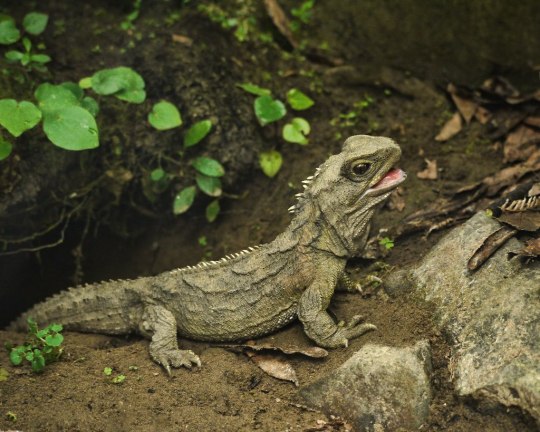
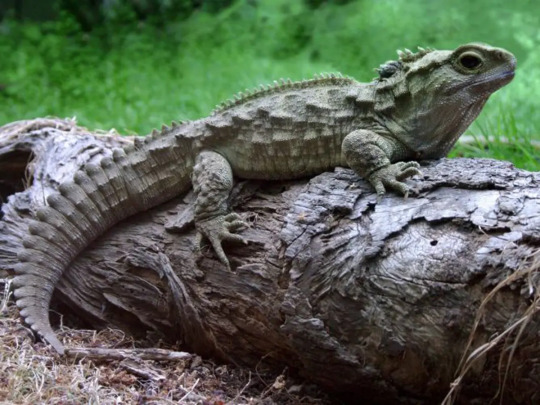
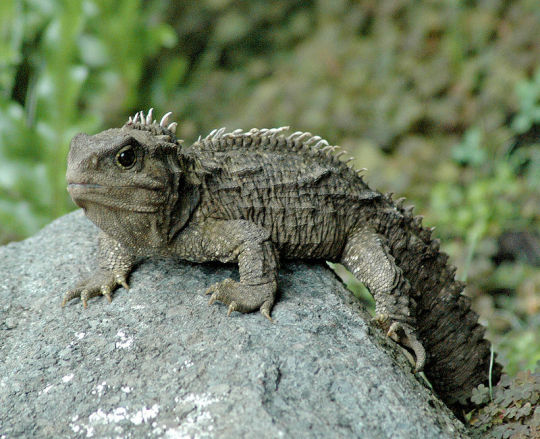
The Tuatara is a species of reptile endemic to New Zealand and its surrounding islands, belonging to the genus Sphenodon. Their name derives from the Māori language, and means "peaks on the back" referencing their unique spiny vertebral crests. Although resembling most lizards, they are part of a unique lineage of reptiles, the order Rhynchocephalia, which originated in the Triassic period around 250 million years ago and flourished throughout the Mesozoic until being near completely wiped out by the KPG mass extinction event some 66 million years ago. Tuatara are typically a mix of green, brown, and gray in color, measure upwards 31 inches in length and upwards of 3lbs in weight. They sport a spiny white crest along the back, two rows of teeth in the upper jaw overlapping one row on the lower jaw, and are able to hear remarkably well despite lacking an external ear. They are also unusual in having a pronounced photoreceptive third eye, which is thought to be involved in sensing circadian and seasonal cycles. Tuataras thrive in temperatures much lower than those tolerated by most reptiles, and hibernate during winter. Their diet consists of insects, arachnids, crustaceans, other arthropods, frogs, lizards, and bird eggs. While juveniles are diurnal, adults are typically nocturnal or crepuscular depending on the season, spending the day inside of shallow burrows which they may share with seabirds such as petrels, prions, and shearwaters. Tuatara probably have the slowest growth rates of any reptile taking 10 to 20 years to reach sexual maturity, and up to 35 years to reach full size. Mating occurs in midsummer typically once every four years. Mothers lay 2 to 19 white, soft-shelled eggs in nesting burrows, which are covered and incubated for 12 to 15 months before hatching. Barring tortoises, tuataras have the longest lifespan of any reptile with individuals regularly living well past 100 years.
37 notes
·
View notes
Text
A Seabird-Safe Fishing Toolkit being developed in New Zealand was presented to more than 80 participants at an APEC roundtable recently, marking a significant step forward in the effort to save the Antipodean albatross and other seabirds from extinction.
The toolkit aims to mitigate against the loss of tens of thousands of seabirds annually including albatrosses, petrels and shearwaters through drowning by being caught by high seas tuna fishing longlines. Southern Seabirds Trust is developing the evidence-based toolkit which outlines simple and cost-effective fishing practices such as bird scaring lines to scare birds away from baited hooks, weighting hooks so they sink quickly away from diving birds and setting hooks at night.
1 note
·
View note
Text
News and articles about marine wildlife
NZ oceans world’s worst for birds eating plastic
The News presented that New Zealand’s Parliament’s Environment Committee shows that the oceans around the country are the most dangerous in the world for seabirds that consume plastic waste. This is due to the fact that many of the rarest and most threatened seabird species reside in New Zealand. According to Forest & Bird, this highlights the increased risk of plastic pollution to seabirds in New Zealand’s waters compared to other parts of the world. It is not just seabirds that are affected; one in every three turtles recovered in New Zealand has died or become ill from consuming plastic waste. Forest & Bird has warned that New Zealand’s ten native shearwater species could face extinction, similar to the impact on Australia’s shearwaters due to ocean pollution. This is because plastic waste fills their stomachs, leaving no room for food, and they cannot distinguish between plastic and real food. “Young birds around the world are being fed plastic waste by their parents, which is causing their death,” warns Ms Baird.
Dumped fishing gear is biggest plastic polluter in ocean, finds report
According to a report by Greenpeace, lost and abandoned fishing gear is the main source of large plastic pollution in the oceans, and is a significant threat to marine life. Commercial fishing operations dump and discard over 640,000 tonnes of nets, lines, pots, and traps in the sea every year, which is equivalent to the weight of 55,000 double-decker buses. The report highlights the urgent need for international action to address this problem, which affects marine wildlife across the globe, including the UK. Abandoned fishing gear, also known as “ghost gear,” is particularly deadly, as nets and lines can ensnare a variety of marine life, from small fish and crustaceans to endangered turtles, seabirds, and whales. The problem is exacerbated by illegal and unregulated fishing, as well as overcrowded fisheries. Recent studies have estimated that ghost gear accounts for 10% of ocean plastic pollution but makes up the majority of large plastic littering the waters. Fishing-related debris accounts for up to 70% of macroplastics found floating on the surface of the ocean. The report highlights that poor regulation and slow political progress on creating ocean sanctuaries that are off-limits to industrial fishing perpetuate the problem. Greenpeace is calling for a UN treaty to provide a comprehensive framework for marine protection and a global network of ocean sanctuaries covering 30% of the world’s oceans by 2030.
1 note
·
View note
Photo

January 15, 2020 - Buller's Shearwater, New Zealand Shearwater, Grey-backed Shearwater, or Rako (Ardenna bulleri)
Found in the temperate Pacific Ocean, these shearwaters breed on the Poor Knights Islands off the North Island of New Zealand. They eat fish, crustaceans, and squid, capturing prey at or near the water’s surface in flight or while swimming. Adults arrive at their breeding colonies in September and chicks leave in May. Pairs dig burrows together under trees or rocks, lining the nests with leaves, twigs, and pebbles. Both parents incubate the single egg and feed the chick. They are classified as Vulnerable by the IUCN because of their small breeding range and face threats from fishing and climate change.
#buller's shearwater#shearwater#new zealand shearwater#ardenna bulleri#bird#birds#illustration#art#water#birblr art
91 notes
·
View notes
Text
Animal Crossing Fish - Explained #207
Brought to you by a mar- quack! Quack! Quack quack quack!
CLICK HERE FOR THE AC FISH EXPLAINED MASTERPOST!
I’m going to talk about the Duck villagers today, because I should have covered them during my original fish explained series since I was covering everything associated with the water anyway. Forgive me.
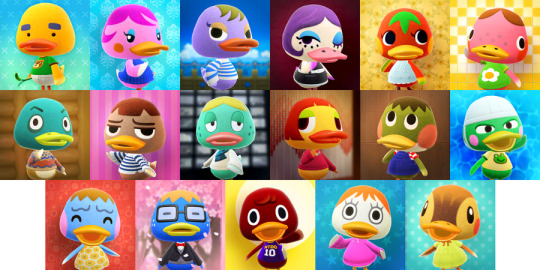
Pic from https://www.sporcle.com/games/Exodiafinder687/animal-crossing-new-horizons-duck-villagers-picture-click
I have covered birds in here before, all of which were seabirds - the penguins and Gulliver who is a gull. But, we all know there are many many birds that take advantage of watery habitats. To list some: seabirds - birds that live out at sea, some of which never see land except when it’s time to nest (ie. albatross and shearwaters); there are shorebirds - birds that rely on beaches and shores to make a living, typically of the saltwater variety (ie. sandpipers, plovers, etc.); wading birds - birds with really long legs and beaks that “wade” through marshland looking for little fish and other small animals to eat (herons, storks, egrets, etc.); and there are waterfowl, the freshwater birds that are famous for floating at the water’s surface (ducks, geese, and swans).
Birds are super unique, and ducks especially - they are some of the few animals that do it all - swim, walk, and fly. They belong in the Order Anseriformes, a group of birds with “pseudo teeth” in their bills (seen most famously in geese), that include 180 known species, though the vast majority (about 170 species) belong to a single family, Anatidae, which are the ducks, geese, and swans. Despite this diversity, many of the AC villagers don’t look like real ducks, which can sport incredible feather colors, patterns, crests, and bill shapes for a myriad of specialized aquatic endeavors. It looks like Molly and Drake are two that are definitively the female and male Mallard duck, (Anas platyrhynchos) (also funny his name is “drake” which is what a male duck is called in the same way a male chicken is a “rooster”)

By This picture was realized by Richard Bartz by using a Canon EF 70-300mm f/4-5.6 IS USM Lens - Own work, CC BY-SA 2.5, https://commons.wikimedia.org/w/index.php?curid=6449086
The mallard is perhaps the most famous duck, being naturally widespread throughout the Northern Hemisphere and introduced to Australia and New Zealand. They, especially the female, make the archetypal duck “quack” we all learn as children. These are the ducks you see and feed bread at the park (please stop doing that - bread is so bad for them!!); they’re your average “wild duck”. But ducks are so much more diverse than you’ll initially realize if you only focus on the Mallard.
The mallard is part of the “dabbling ducks” in the subfamily Anatinae. They are the species you would most recognize as ducks and most likely the group all the duck villagers come from. Females are typically very drab to help them camouflage their nests which they often lay on the ground. Dabbling ducks are mostly omnivorous, eating mostly anything they find when they “bottom-up” and use those flat bills to rummage around in aquatic vegetation and sediment. The males are often brilliantly-colored to attract females and some sport patterns and crests that rival birds of paradise. Like, look at this bastard:

By Adrian Pingstone - Own work, Public Domain, https://commons.wikimedia.org/w/index.php?curid=592287
This is a mandarin duck, Aix galericulata, and damn he look like he was painted.
Still - there are also diving ducks, like this Greater Scaup (Aythya marila),
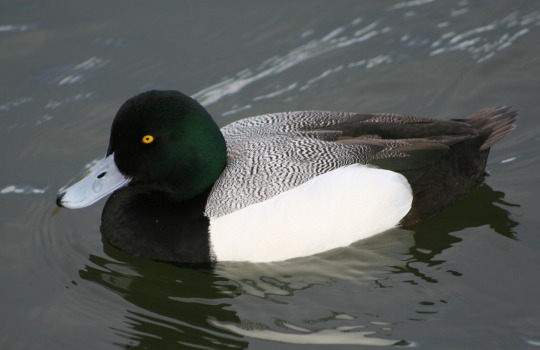
Calibas, CC BY-SA 4.0 <https://creativecommons.org/licenses/by-sa/4.0>, via Wikimedia Commons
...and wouldn’t you know it, there are also sea ducks that live in saltwater. These are your scoters, eiders, and other friends in Tribe Mergini, like this King Eider (Somateria spectabilis).
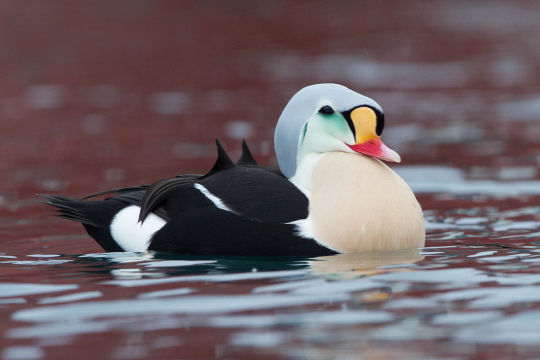
By Ron Knight from Seaford, East Sussex, United Kingdom - King Eider (Somateria spectabilis), CC BY 2.0, https://commons.wikimedia.org/w/index.php?curid=32940131
Okay, we’ll be here all day if I show you every duck I think is cool. But like, my point is that AC missed a great opportunity to go wild with their ducks. At least they picked some great ducks for the wooden Decoy Duck item you can customize: https://nookipedia.com/wiki/Item:Decoy_Duck_(New_Horizons). Of course I made 7 and spread them all over my island.
And there you have it. Fascinating stuff, no?
#duck#animals#animal crossing#bird#animal crossing villagers#acnh#acpc#acnl#eider#sea duck#science in video games#animal crossing fish explained
2 notes
·
View notes
Photo

2019 Highlights: Another year working with the best birds - seabirds! I'm one year in to my 3-year PhD project on shearwaters and prions, and I'm also working on a number of projects for the Northern New Zealand Seabird Trust, which means lots of time in the field. The best part of this year was installing some nest boxes that were immediately taken up by pakahā - fluttering shearwaters. This little baby is the first one to hatch and grow in one of these nice new nest boxes! Does that make me a bird mum? It totally does. Part of my research is checking on these chicks to see how healthy and fat they are before they fledge - this little one is doing very well, which is very encouraging. ⠀ ⠀ All my bird handling is done with the appropriate Wildlife Act authorities and permits for working with wild animals, as well as being cleared by research ethics approval. Please never open nest-boxes or handle birds (or any other critters!) if you don't have the permits to do so - disturbing wildlife is illegal, and our native species have a tough enough time without being disturbed by humans. ⠀ ⠀ #birdventurenz #thebrillianceofbirds #womeninstem #fieldbiologist #your_best_birds #birds_adored #birds_brilliance #conservationphotography #nzbirds #birdventure #conservationphotographer #biologist #docgovtnz @docgovtnz @forestandbird #wildnz #birdstagram #birdsofinstagram #eye_spy_birds #nuts_about_birds #aotearoa #explorenz #seabird #scientist #seabirdscience #newzealand #discoverearth #wanderwonder #petrelhead #shearwater #fieldbiology #bird_lovers_daily https://www.instagram.com/p/B6tTz0EpLw8/?igshid=10i1ff0sfedcn
#birdventurenz#thebrillianceofbirds#womeninstem#fieldbiologist#your_best_birds#birds_adored#birds_brilliance#conservationphotography#nzbirds#birdventure#conservationphotographer#biologist#docgovtnz#wildnz#birdstagram#birdsofinstagram#eye_spy_birds#nuts_about_birds#aotearoa#explorenz#seabird#scientist#seabirdscience#newzealand#discoverearth#wanderwonder#petrelhead#shearwater#fieldbiology#bird_lovers_daily
6 notes
·
View notes
Text
neuseeland flora und fauna (6)
campervan hire New Zealand here. At Taiaroa Head on the east side of the Otago Peninsula, there is the world's only mainland Royal Albatross colony. The only access is through the Royal Albatros Center. Cormorants, various species of gulls, shearwaters, terns and petrels can also be seen along the coasts. Iron-rich and therefore dark, the sand is on the west coast of the North Island, whose coast is more suitable for swimming and surfing than that of the South Island. In the mountains of the South Island, several of these glaciers have formed over time. One of the most famous is the Franz-Josef-Glacier that was discovered in the year 1865 by its German discoverer after Emperor Franz Josef I. The glacier was so big approximately 150.000 years ago that it completely included the surrounding mountains.
Discover Deutschlandfunk
In 1975, the Waitangi Tribunal was finally set up, which makes regulations in the event of disagreements and breaches of contract and also makes reparations.
Due to the additional human intervention in nature, many bird species have been brought to the brink of extinction and even entire populations have been wiped out.
For several reasons New Zealand has a high number of different vegetation formations.
This policy was successfully practised for decades until changed conditions led to another radical change of course.
The center around the Cathedral Square is still restricted area. Our youth hostel is also located in this restricted zone.

new Zealand wildlife
After this level follows a short but crisp climb over the Mangatepopo saddle (1.690m) to the edge of the Red Crater (1.868m). In this caldera, a path to the left leads to the Soda Springs, cold springs around which moisture-loving plants grow. During the following ascent of almost 350m, unfortunately with stairs, one crosses the area called "Devil's Staircase". The youngest black lava flows are from the eruptions of the years 1949 and 1954.
1 note
·
View note
Text
neuseeland fauna und flora (3)
Why are there no snakes in New Zealand?
Flora and Fauna, Flora and Fauna in New Zealand New Zealand's flora and fauna was created through 70 years of isolation. A trip to New Zealand will therefore not only bring the visitor closer to the immeasurable vastness of the landscape, but will also present him with a unique flora and fauna.
Particularly impressive is the Royal Albatross, which can have a wingspan of up to three and a half metres (easy to see on the coast of Dunedin). At Taiaroa Head on the east side of the Otago Peninsula there is the world's only mainland Royal Salbatro colony. The only access is through the Royal Albatros Center. Cormorants, various species of gulls, shearwaters, terns and petrels can also be seen along the coasts.
The plains are largely used as farmland and pasture land.
The evergreen vegetation once covered more than 2/3 of the country.
> While the main islands of the archipelago are never wider than 450 km in east-west direction, they extend along the main axis in northeast direction for more than 1600 km.Kauri snails live almost exclusively in the ancient Kauri forests of Northland and reach an age of up to 20 years.>|}
The native false beech thrives at lower altitudes in the New Zealand Alps and is replaced by high mountain vegetation at higher altitudes.
>>/ul>
Travel to Mayan ruins and volcanoes - highlights in Guatemala
Read more about campervan hire New Zealand here. The view is fantastic when suddenly the light of the lamps goes out and the starry sky rises. One of the most interesting phenomena on New Zealand is the fungus mosquito larva.
Survive 3 minutes without air, 3 hours without protection in very bad conditions, 3 days without water and 30 days without food. Seek shelter in the dark or in bad conditions. Try to give signals by using colours or light. Actually a nice contribution, but I noticed that you confuse North and South Island in the text.
1 note
·
View note
Text
21 things about me & 21 tagged
@davidlieberman tagged me!
Nickname/s: uhhh I don’t really do nicknames? i guess?
Zodiac sign: leo sun aries moon, to everyone’s surprise
Height: 5′2″
Hogwarts house: ravenclaw
Last thing I googled: “tsh hormone.”
Fave music: indie bullshit, if I’m being honest :(
Song stuck in my head: "talk” by hozier since it’s the last song I listened to
What I follow: on tumblr… friends, friends of friends, people who post aesthetics I like and the occasional witchcraft/hellenic polytheism blog?
Followers: 1,417
Do I get asks: not really? sometimes.
Amount of sleep: my body would really like me to get 10+ hours every night apparently, but usually 6-8.
Lucky numbers: 3, 5, 13
What I’m wearing: fave blue flannel, black skinny jeans, hard-soled oxford-adjacent shoes that tap pleasantly when I walk.
Dream job: oh god idk. no job under capitalism tbh. I’d like to write and otherwise create, free of strictures.
Dream trip: I’d like to go back to new zealand or greece or the pnw, but also specifically st. mark’s wildlife refuge in florida.
Favorite food: tacos, yellow curries.
Instruments: I used to sing in a choir but I’m mediocre, was terrible at violin in high school orchestra while somehow managing first chair, can pick out the occasional simple chorded song on guitar.
Languages: english, french, can puzzle out some spanish/catalonian from knowledge of french, the tiniest bit of ancient greek.
Favorite songs: oh god you ask this as if I don’t listen to albums on repeat for months and then abruptly switch but uhhh
broken horse by freelance whales
as it was and cherry wine by hozier
rooks by shearwater
lay down in the tall grass by timber timbre
wings by josh ritter
idk there’s a lot more but how does one even do this
Random fact: my parents and I raised chickens for eggs in our backyard for a while?
Aesthetic: some kinda genderless bog witch but also occasionally the early 20th century dandy thing a lotta transmascs on here are obsessed with will lure me.
Tagging: oh god I don’t know 21 people. @renmorris @sybilreisz @thegayze @stuffedgrapeleaves @an-gremlin @coronersgambit @captain-habit @cyanpeacock @transhamlet @transwolvie @inter5tellas @phlora @schroedingersbitch @gei-r @metalkoromon @kahswan @scarhaver @anaryllis @bitterspring @tygale @gordoncoleofficial holy shit i did it. anyways no pressure and also other people can say i tagged them if I want.
12 notes
·
View notes
Text
Day 7 in New Zealand: Marlborough Sounds
Today we had a fantastic tour of (parts of) the Marlborough Sounds by boat!
We had to be up a little earlier than I would’ve preferred, but it was worth it. We walked to the wharf where our guides picked us up in a 90-year-old boat, and then it was off into the Sounds!
The scenery was spectacular. The Marlborough Sounds are a drowned river valley: the sea level rose after the last ice age and filled in what had been a river valley surrounded by ridgy hills.
While motoring out toward our first island stop, we got to see a few seals (one or two in the water; more napping on the edges of islands, each of them rather incongruously accompanied by a seagull friend or guard), a fair number of pied shags and spotted shags (“shag” is the New Zealand name for “cormorant”), and--excitingly--several blue penguins! Blue penguins are also called little penguins, and they are in fact very small and cute! Unfortunately, the dolphins weren’t around, but we’ll probably see some later in the trip.
We eventually stopped on an island for a short walk along a trail to a waterfall. We heard some birdsong but only got a good look at one bird--a very friendly fantail that actually followed us along for a bit and hung out nearby, letting us get a very good look at it. Very cute! Back at the shoreline, there was a pair of paradise shelducks, and we saw a seagull fly up to drop a shellfish down onto the rocks to break it open with a satisfying thunk.
We ate lunch back on the boat, then went across to Motuara Island, which is a predator-free ecosanctuary with lots of birds. We walked up the trail to the lookout at the top, which had gorgeous 360-degree views. We did get to see some birds on this island, though not many: a few bellbirds, a welcome swallow, a South Island saddleback (different from the North Island ones we’d seen in Zealandia), and a South Island robin which ... looked nothing like either the American robin or the English robin. It was smallish, mostly black but with a cream belly and a white “mustache” over the beak. But what was startling was how very inquisitive it was: it came right up to us, nearly hopping onto my foot! We also heard a kakariki (a New Zealand parakeet), but didn’t see it. The other great thing on this island was its myriads of lichen and moss.
Overall, a wonderful day. Two of us got to take a turn steering the boat, and our guides were terrific. On the trip back in, we saw lots of fluttering shearwaters. We were dropped off at the wharf in Waikawa Bay just after dark.
We went out for dinner in town and bought some groceries for tomorrow’s dinner. When the taxi brought us home, we realised that it was quite a clear night, so we stood out on the balcony admiring the stars for a bit. We’re out of the main town and it’s very dark here, so we could see the Milky Way, Scorpio, and the Southern Cross. I even saw a shooting star!
My inner ear has not yet readjusted to solid ground. I hope it won’t interfere with my sleep!
8 notes
·
View notes
Text
If you guys want to vote for something that isn’t extremely depressing this year may I introduce:
NEW ZEALAND BIRD OF THE YEAR 2020:
pick 5 NZ birds to vote for - there’s information available about each one and their conservation status
you can vote no matter where you’re from and what age - all you need is your name and email!
it’s open from the 2nd to the 15th of November
it’s always a fun but really big deal!
I’ve personally voted all seabirds this year - they tend to be overshadowedby more charismatic species, and a lot of them are in big trouble! If you want some ideas, I’d highly recommend giving these following guys some love: Bar-tailed godwit, Hutton’s Shearwater, Variable oystercatcher, Red Knot, Black Stilt, Black-billed Gull, Wrybill, and the Yellow Eyed Penguin!
Vote here!!!
#bird of the year gets INTENSE#TEAM BLACK BILLED GULL#zoology#ornithology#birds#birdblr#new zealand#nz#voting
219 notes
·
View notes
Text
I was tagged by @andriacrowjoy!
1. Nickname: Chris
2. Zodiac: Scorpio
3. Height: 5’9
4. Last movie i watched: Ummm. I don't really watch movies anymore.
5. Last thing i googled: typewriter user manual Underwood 378
6. Favorite musician: Multiple way tie for Cloud Cult, the National, and Shearwater
7. Song stuck in my head: "Raggedy Man" by Haley Bonar ("Raggedy man, raggedy man, I don't wanna be your Raggedy Ann") - it was the last song that played in the car as I arrived home after work earlier
8. Other blogs: Nothing else on tumblr, but I have a long-running, barely alive WordPress blog
9. Do i get asks: Very rarely. Having anon turned off perhaps contributes to that, but life is too short to bother with salty anons
10. Blogs following: 266
11. Amount of sleep: 5-6, with earplugs and medication - sleep is not my friend
12. Lucky number: 17
13. What I’m wearing: black sweatpants and an old, faded black t-shirt
14. Dream job: I'm not sure that I really have one!
15. Dream trip: New Zealand to visit @emmaseasall
16. Favorite food: peanut butter toast
17. Play any instruments: Not anymore, but I took piano lessons for over a decade, guitar lessons for a few years, and played saxophone in junior high band
18. Languages: English
19. Favorite songs: "Transistor Radio" by Cloud Cult, "Circles" by Passenger, "Animal Life" by Shearwater, and many more...
20. Random fact: I've worked for the same company since the summer of 1996
21. Describe yourself as aesthetic things: Purple and black typewriter ribbons, messy piles of books, black zipper hoodies, sleepy black cats, rainbow colors across the pages of a handbound art journal
I tag: @pr-scatterbrain, @stars-bean, @hello-emotiful-me, @urrone, @pinetreelady, @kimmiesue13, @gilajames, and anyone who wants to play along
7 notes
·
View notes